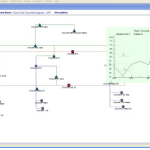Oil & Gas Software with Merrick
There comes a time in the life of any oil and gas software product when it’s time to consider modernization. Several Entrance employees attended Merrick’s user event, MUG, earlier this week.
During the afternoon session on ProCount’s allocation re-write, the speaker brought up some interesting thoughts surrounding the topic of oil and gas software that are worth highlighting in a more general sense.
What’s Under the Hood of Your Software?
One way to think about software and whether it is meeting your needs is car ownership. You have a car, it gets you from point A to point B, but not all cars are made equal. When you look under the hood, maybe the engine has more horse power or the transmission is worn out.
These factors make a difference in your evaluation of whether that car is a good fit for you. If you’re a race car driver versus someone who commutes two miles to work, the need is obviously very different. In addition, features like ease of driving or leather seats may also be a concern.
 The same goes for oil and gas software. The Merrick speaker shared several reasons why it might be time to upgrade your software for a better “ride”:
The same goes for oil and gas software. The Merrick speaker shared several reasons why it might be time to upgrade your software for a better “ride”:
- Written with a different assumption set
Does your software need to support a larger diagram? Have the number of wells under production doubled? If so, then the original assumptions for purchasing or building your oil and gas software are probably outdated and should be re-evaluated.
- Too processing intensive for systems that have grown
Small companies turn into mid-size ones, and when they do, processes that efficiently worked for small data sets become agonizing for larger ones. The time wasted for this alone can make an upgrade worth your while.
- Too cumbersome for multi-tasking
How many windows do you have to open or buttons do you need to click to get to the right information? This is another time waster that should be factored into your decision.
- Limited diagnostics when things go wrong
If you run an allocation and something fails, does your oil and gas software have the ability to diagnose the problem? If not, you’ll probably spend more time than you’d like diagnosing the problem manually, and you may still be missing something.
- Increased emphasis on real-time data
In the past, instant data was not as easy to obtain, nor was it the expectation. Now that we have the capability, the consequent improvement in decision making translate this into an attractive option.
For more on choosing the right software for the oil and gas industry, check out this page that walks you through buying versus building!

